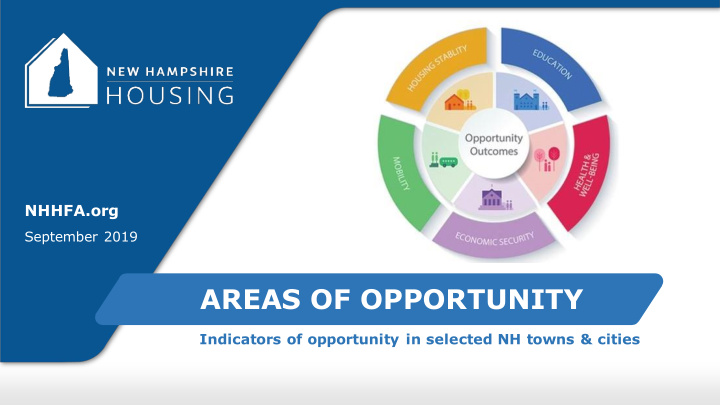



NHHFA.org September 2019 AREAS OF OPPORTUNITY Indicators of opportunity in selected NH towns & cities
Purpose of Project This opportunity area comparison quantifies the level of opportunity in New Hampshire (as defined by the Opportunity Atlas and Opportunity360) ▪ Neighboring towns and cities are compared to observe their level of opportunity ▪ Areas have been selected based on perceived variation in "opportunity" ▪ This is not the same as "Opportunity Zones" ▪ The terms used to define higher opportunity areas in Michigan and Georgia are applied to these New Hampshire towns to see the effect that a similar scoring criterion would have in the NH QAP Areas of Opportunity 2
Opportunity360 indicators are based on 2010 census data
The Opportunity Atlas • Opportunity Atlas indicators show the average outcomes in adulthood for people who grew up in each census tract (born between 1978 and 1983) • Household income presented here will show the outcome for r a chil ild from this area whose par arents were re in the 25th income percentil ile • For example: on average, children who grew up in downtown Nashua with parents in the 25th income percentile have a household income of $28,535 in their 30's.
Manchester and Bedford
Nashua and Hollis
Lebanon and Claremont
Franklin and Canterbury
Littleton and Lancaster
Gilford and Laconia
Michigan QAP Comparison • Michigan allots 1 point for each score of at least 66 in the categories (up to 4 points): • Education • Health & well-being • Economic security • Jobs, goods, and services • If NH adopted Michigan's point allocation for opportunity areas: • Blue uebar = 3 points • Greenbar = 2 points • Yellow llowbar = 1 point • Red bar = 0 points *no locations earned points in the "jobs, goods, and services" category
Georgia QAP Comparison • Georgia allots 2 points for projects that score 60 or higher in two of the categories, or 1 point for a score of at least 60 in one category: •Housing stability •Economic security • Health & well-being • If NH adopted Georgia's point allocation for opportunity areas: • Greenbar = 2 points • Yellow llowbar = 1 point • Red bar = 0 points
RESULTS Opportunity360 scores generally correlate to Opportunity Atlas income mobility Considerations: ▪ Social fabric ▪ Low opportunity scores indicate increased need ▪ Communities on the margins NAME OF PRESENTATION 13
New Hampshire Housing Contacts Natasha Dube Elnaz Najdmazhari Director of Housing Development Program Manager, LIHTC enajdmazhari@nhhfa.org ndube@nhhfa.org NAME OF PRESENTATION 14
Recommend
More recommend